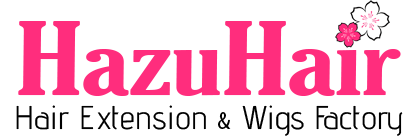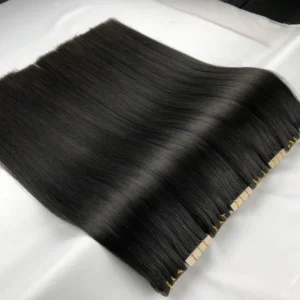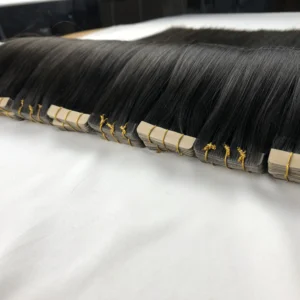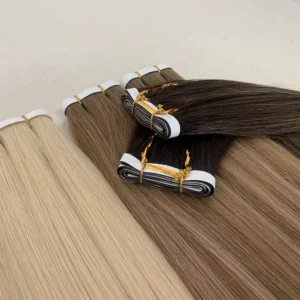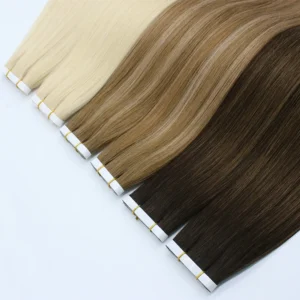Normal Tape-In Hair Extensions
Normal Tape In Hair Extensions with Autumn Brown Hair Color Straight Hair
Normal Tape-In Hair Extensions
Normal Tape In Hair Extensions with Ombre #60 Color Straight Hair
Normal Tape-In Hair Extensions
Normal Tape In Hair Extensions with Platinum Silver Straight Hair
Normal Tape-In Hair Extensions
Normal Tape In Hair Extensions with Black Color Straight Hair 100% Vietnamese Human Hair
Long Tape-in Hair Extensions
Long Tape In Hair Extensions with All Color Straight Hair 100% Vietnamese Human Hair
Long Tape-in Hair Extensions
Long Tape In Hair Extensions with Ombre #27 Color Straight Hair
Long Tape-in Hair Extensions
Long Tape-In Hair Extensions with Straight Hair Natural Black Color
What are Hair Extensions?
Hair extensions are artificial or natural hair pieces that are added to a person's existing hair to create the illusion of longer, thicker hair. They come in various types, styles, lengths, and colors to match a person's natural hair or to achieve a completely different look.
Hair extensions serve several purposes:
- Achieving Longer Hair: Extensions can instantly add length to your natural hair.
- Creating Thicker Hair: They provide volume and fullness for a more luscious look.
- Adding Color: Extensions can introduce highlights or vibrant colors without the commitment of dyeing your natural hair.
There are numerous types of hair extensions and various application methods. Some extensions are semi-permanent and typically require professional application, while others are temporary and designed for at-home use, allowing you to apply them yourself in just a few minutes.
Hair extensions are also popular for special occasions, such as weddings, proms, and other significant life events. If you have a specific hairstyle in mind that you can’t achieve with your natural hair, consider using hair extensions or consulting with a trusted hairstylist for advice on how extensions can help you achieve your desired look.
At HazuHair, we offer DIY clip-in hair extensions, which are the easiest and safest way to enhance your hair at home. Our clip-in extension wefts come with pre-attached clips, allowing you to effortlessly clip them into your hair without needing professional assistance or incurring additional costs. They are ideal for everyday wear and for those special occasions when you want a quick transformation.
What Types of Hair Extensions Are There?
There are several types of hair extensions, primarily distinguished by their application methods. Some extensions are temporary, while others are semi-permanent. When deciding which type to choose, it’s advisable to schedule a consultation with a hair extension technician, particularly if you are considering semi-permanent options. A professional can help assess your hair type, needs, and goals to find the best solution.

Clip-Ins
Clip-in hair extensions feature clips sewn onto the base of each weft. These clips can be easily opened and attached to the roots of your hair, then snapped shut. Each weft is layered beneath your natural hair, creating an immediate effect of longer and fuller hair while remaining undetectable. Clip-ins can be applied at home in just a few minutes and do not damage your natural hair, eliminating the need for professional assistance.Tape-Ins
Tape-in hair extensions are pre-taped and applied by gluing sections of your natural hair between two taped wefts. This method typically requires a professional for proper alignment with your hair roots, using a heated tool to secure them in place. Tape-ins are a semi-permanent solution that needs to be replaced every 1-2 months. However, the application process involves heat and glue, which can potentially damage your hair.Sewn-Ins
Sewn-in extensions involve a more intricate process. Your natural hair is first braided into cornrows, and then the weave is sewn into these braids using a needle and thread. This method can take several hours and is generally recommended for those with thicker hair, as the tight application can put strain on the scalp. Due to its complexity, this type of extension should be done by a professional.Micro Links
Micro link hair extensions use small silicone-lined beads to attach tiny wefts of hair to sections of your natural hair. A special tool secures the bead in place. This method requires a professional to ensure proper application, which can take several hours. While micro links do not involve heat or glue, the tension from the beads can still cause damage to your natural hair over time.What Are Hair Extensions Made Of?
Hair extensions can be crafted from either real human hair or synthetic fibers. For the most natural look and longevity, we recommend choosing human hair extensions, as they can be styled just like your own hair.Real Human Hair Extensions
Pros:- Can last up to a year or more
- Can be heat styled
- Can be dyed
- Provide a natural appearance
- Can be washed like your own hair
- Generally more expensive, often costing over $100 depending on the style
Synthetic Hair Extensions
Pros:- More affordable than human hair extensions, starting at around $50 depending on the style
- Shorter lifespan (typically 1-3 months)
- Cannot be heat styled or dyed without causing damage
- Usually do not look as natural as real human hair
- Cannot be washed
Do Hair Extensions Ruin Your Hair?
Semi-permanent hair extensions can potentially cause damage to your hair due to the bonding, gluing, and consistent pulling involved in their application. On the other hand, temporary hair extensions, such as clip-ins, do not harm your natural hair at all.
This is because clip-ins are simply attached to the roots of your hair and removed daily, resulting in minimal pulling. If you're worried about the health of your hair or its longevity, we recommend opting for a temporary DIY solution like clip-ins, or consulting with a hair extensions technician for professional advice.
How Do I Choose the Right Color of Hair Extensions?
When selecting the right color of hair extensions, the key factor is to consider the undertones in your hair. Whether your hair leans warm, cool, or neutral, it's essential to choose a color that matches your undertones.
To determine your hair’s undertones, observe your hair in natural light (such as near a window or outside). If you notice yellow, golden, or red hues, you have warm undertones. If you see blue or green tones, you have cool undertones. If you're seeing a mix, you likely have neutral undertones.
When looking for the right hair extension color, pay attention to product descriptions, as they often indicate the undertones present in the hair. You can also look for specific terminology that companies use to define warm, cool, and neutral shades:
- Warm: Names to look for include Golden, Butterscotch, Honey, Chocolate, Mocha, and Cherry.
- Cool: Names to watch for include Platinum, Ash, Cool, Walnut, and Icy.
- Neutral: Names like Natural, Medium, or Neutral are commonly used for neutral tones.
Can I Wash, Heat Style, and Dye Hair Extensions?
Whether you're using temporary or semi-permanent hair extensions, if they are made from real human hair, you can treat them just like your own hair. This means you can wash, dye, and heat style them without any issues.
However, when it comes to synthetic hair, dyeing is generally not recommended. Synthetic hair has already been chemically treated during manufacturing, which means it may not hold up well to the dyeing process. Additionally, applying heat can damage synthetic hair, causing it to melt, and frequent washing can diminish its quality.
If you decide to dye real human hair extensions, it’s advisable to avoid bleach. While human hair can typically handle bleaching, it may compromise the quality and lead to irreversible changes. Unlike your natural hair, which benefits from the natural oils produced by your scalp, hair extensions do not receive these moisturizing benefits, so they may require extra care.
You can wash real human hair extensions using most shampoos and conditioners you use on your own hair. However, be cautious of products containing sulfates and alcohol, as these can dry out the hair. Before using any heat styling tools, always apply a heat protectant and use a low to medium heat setting. Remember to keep the tool moving to prevent heat damage.
How Much Do Hair Extensions Cost?
The cost of hair extensions varies widely based on several factors, including the type of hair extension, application method, length, weight, and hair color.- Type of Hair Extension: Synthetic hair extensions are generally more affordable than real human hair extensions. The production process for real human hair is more complex, involving sourcing and manufacturing that increases costs. However, real human hair extensions typically last longer than synthetic ones; with proper care, they can last a year or more. Prices for synthetic hair extensions usually range from $20 to $80+, while real human hair extensions range from $100 to $500+.
- Length and Weight of Hair: Longer and heavier hair extensions are more expensive due to the additional material used. For example, a 16” 140g Classic Clip-In set may be priced between $185 and $225 USD, while a 24” 240g Classic Clip-In set can cost between $339 and $385 USD.
- Hair Color: Color can also influence the price, particularly when comparing solid shades to multi-toned options like balayage or highlights. The extra time and resources required to achieve a two-toned effect can increase costs.
- Application Method: Semi-permanent hair extensions typically cost more since you're paying for both the product and the professional's application skills. They also require regular maintenance visits to ensure they stay in place and look natural. In contrast, temporary hair extensions are generally more affordable, as you have the flexibility to wear them only when desired. With proper care, temporary extensions can last a year or longer.
How Long Do Hair Extensions Last?
The lifespan of hair extensions depends on the chosen method and how well they are cared for. Generally, temporary hair extensions like clip-ins last longer since they are not worn continuously, unlike semi-permanent extensions. Here are average lifespans for different types:- Clip-Ins: 6-12 months
- Tape-Ins: 4-8 weeks
- Sewn-Ins: 6-8 weeks
- Microlinks: 3-4 months
- Wigs: 10-12 months
What Do the Different Weights Mean?
The weights listed with hair extensions indicate the thickness of the set, specifically how much hair is attached to the wefts. Most companies measure the weight of their extensions in grams; generally, a higher gram count signifies thicker extensions.
For instance, a full set of extensions classified as lightweight, meaning it has less hair attached to the weft, typically weighs around 120-140 grams. In contrast, a full set considered thick and heavy, with a substantial amount of hair attached to the weft, usually weighs 220 grams or more.
To choose the appropriate weight for your hair type, first determine your natural hair thickness (thin, medium, or thick). It's advisable to select a weight that corresponds to your hair thickness rather than the thickness you wish to achieve.
This is important because selecting a weight too different from your natural hair can make blending difficult. For example, if you have thin hair and desire maximum volume, opting for the heaviest set available (220 grams or more) may lead to discomfort, as the extensions could weigh too heavily on your hair. A light to medium weight (between 120-180 grams) can still provide a full and voluminous look without causing discomfort.
Conversely, if you have very thick hair and are not looking to add extra thickness, choosing a lighter weight set (anything less than 220 grams) may result in extensions that are too thin for your hair, leading to a stringy appearance when applied.
Where to Buy Good Hair Extensions?
While hair extensions is widely available in the global market, it’s important to be cautious of low-quality products that can damage both your hair and health. To ensure you receive the best results, always choose reputable brands known for their high-quality hair.
Though hair from regions like Brazil, Malaysia, India, and South America is popular, these options can be very expensive. An excellent alternative is Vietnamese hair extensions, known for its softness, smoothness, and strength. Vietnamese women’s hair is naturally long and healthy, offering a perfect blend of thickness to match other types of human hair.
For top-tier Vietnamese hair extensions, look no further than HazuHair. With over 10 years of experience, HazuHair is a trusted brand offering premium hair extensions at competitive prices. Our hair is sourced from reliable donors across Vietnam, ensuring that every bundle is just as beautiful, fresh, and vibrant as it appears in our photos.
HazuHair’s commitment to quality makes it an ideal choice for clients seeking the best Raw and Remy hair.
The HazuHair Difference
At HazuHair, we pride ourselves on offering hair extensions that are sustainably and ethically sourced from rural communities across Vietnam. Each strand is collected by skilled hair collectors with years of experience, and we ensure fair compensation for the hair we trade.
Unlike many mainstream brands that rely on European, Russian, or Remy hair—which tend to have a coarser texture—Vietnamese hair is naturally finer. This results in extensions that are lightweight, dry faster, and feel more comfortable to wear.
Vietnamese hair also lightens with greater ease, producing cool, brass-free tones and a vibrant colour that ages gracefully. Our advanced processing technique, which takes 1-2 weeks, is carried out in gentle stages to maintain the hair’s natural integrity. We never use harsh chemicals or silicone, allowing the hair to retain its strength, shine, and natural beauty for much longer.
Our processing method ensures that the hair cuticles remain intact and undamaged, reducing the risk of matting, tangling, or breakage—common problems in chemically treated hair. By using high-quality hair, our stylists can achieve perfectly blended tones, offering seamless colour customisation for every client.
One of the most distinctive features of HazuHair is the significantly reduced drying time. While many extensions require lengthy drying processes, our ethical processing methods result in hair that dries in half the time, making it more convenient and effortless to maintain.
We offer our clients hair extensions that are not only easy to maintain but also time-efficient, with a natural and seamless appearance. At HazuHair, we value authenticity and are proud to deliver life-changing extensions that look and feel completely natural.
